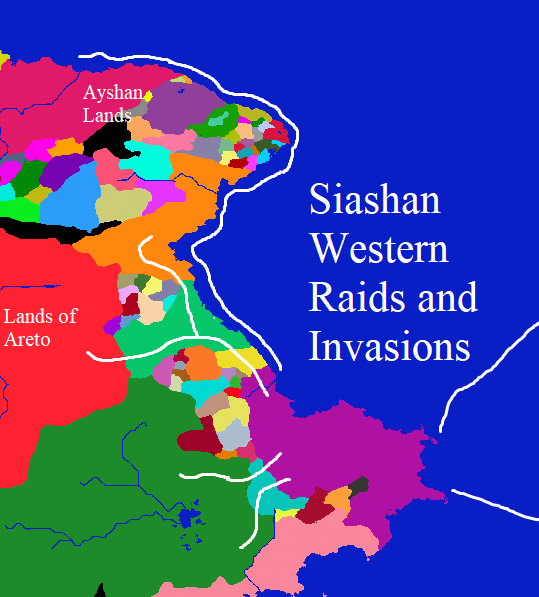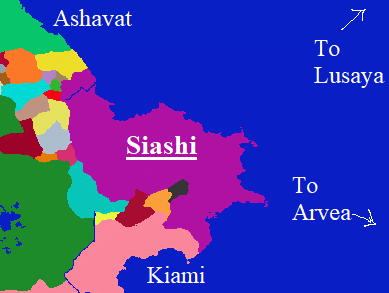Kingdom of Siashi
The Kingdom of Siashi is a prosperous trading kingdom on the Eastern edge of Samvara. It is the gateway to the East, to Desmia and Izekra, and its ports are friendly to merchants and travelers from around the world. Much show is made of "freedoms" and "justice". Much show is made of prosperity and innovation. But make no mistake, this is no land of libertines or pluralists. This is a deeply faithful, militaristic kingdom. And should you wander beyond your designated areas of freedom, you may just dissapear.
Despite the danger for foreign travelers, many risk leaving the ports anyways. The land is just so beautiful: the coastline, covered in mangrove trees and white-sand beaches; the sweeping fields and dramatic plateau views. Even the mountains, which spew smoke and smog from the Kima Cities below, have a beauty to them. As long as you keep your head down and your holy symbol on, such sightseeing isn't even that dangerous. The people here are friendly to pilgrims, if a little judgy at times. The casual shrug with which Siashi can drift between welcoming and oppressive is scary like that.
Structure
Siashi is a religiously charged monarchy with a plutocratic constitution. The monarch must be of the greater Lilivar tribe (a descendant of Lily of Red ) and must be of the Dakaviri sect of Halikvar and approved by the Archdruid of Halikvar. The monarch has great legislative and executive power, but cannot infringe on a number of culturally-enshrined liberties: a right to property, a right to jury trial, a right to elect local tax overseers. The current monarch is King Sevim I, a popular and principled monarch that has been carefully trying to emphasize commerce and industry over raiding and militarism. Sevim's cool temper and focus on infrastructure and ethics has not made him a pacifist, though, and his speeches betray a deep hunger for glory.
A mixture of bureaucrats and rural aristocrats manage the lower level administration. The nobility has been decline for centuries, ever since serfdom was abolished by the Republic, but clings to life in the less-connected corners of the country. The Ministries of Commerce and Works manage trade, taxes, and infrastructure. Local noble titles are often rented to military officers and notables for spans of around five years. These title rentals are renewable, but do make for a very impermanent kind of psuedo-feudalism led by the merchant-military elite.
The Kima Cities of Siashi's Southern mountains have a constitutional right to self-government and autonomy, but still nominally recognize the rule of the monarch. A special government position, the Master of the Depths, acts as the manager of Kima City policy.
Culture
Cultural Quirks and Customs
Spaces, Rights, and the Individual
History
Siashi before Unification (0 - 720 ME)
The First Kingdom (720 - 1130)
Wars for the War Goddess (1130 - 1400)
Republic of Brethren (1400 - 1700)
The Current Regime (1700 - Present)
Demography and Population
Territories
Siashi is 596 miles across, and 205 miles across. Much of its borders are defined by the Rejvala mountains, which rise to about 5000 feet above sea level. There is a large, raised plateau in Eastern Siasha, next to the Rejvala, and this plateau is cooler and drier than the surrounding land. Quite a few islands line the coasts, especially around the Eastern peninsulas.
The Serevnar river, 90 miles long, is at the center of the Northern region of Sereva, which is contested by a number of lesser princes in the region.
Siashi sits at the closest point to both Desmia and Arvea, and the winds make travel to both locations convenient. Leviathan attacks are not unheard of along the way, though.
Military
Siashi has an excellent navy and a robust army. Much of the navy contract as merchants and privateers when off-duty, though a core standing navy stands guard over the main ports at all times. A large chunk of the army contracts out with these merchants and privateers as marines and guards. The army, like the navy, is composed of a core standing army and a number of semi-mercenary warbands and regiments organized by local merchant-bureaucrats.
The warriors of Siashi focus on mobility over line strength. Siashi's archers and crossbowmen are quite skilled sharpshooters, and are often armed with large shields bearing the full moon symbol of Lily of Red. Highly mobile infantry armed with axes and short swords are common as well and often are quite skilled at boarding vessels.
On land, the Siashian strategy is to divide, wear down, and confuse the enemy, ideally separating their forces across the battlefield. Once the enemy is divided, a strong central force of mixed infantry and heavy-hitting specialists can target the most threatening group of enemies, and the foes can be surrounded and destroyed one by one. These specialists tend to be holy orders of some kind or another: cavalry or heavy infantry, oftentimes.
The most famous specialists are those of the Wargrove. The Wargrove are a group of Treants (druidically awakened trees) that have dedicated their long lives to fighting for the Halikvar cause. Founded by the ancient Oak-paladin Etsaba the Walking Temple, the Wargrove is a mixture of paladins, druids, berserkers, and sharpshooters armed with specialized ballistae. They are extremely controlling of their members and relentlessly indoctrinate all who join. They train endlessly to better awaken more trees to enlist in their cause, so that they may one day be a great army that walks as an armored forest.
Religion
Siashi is majority-Halikvar and considers it their state religion. The courts are Halikvar, all officials must be Halikvar. The official state sect is Dakavar - a group who preach total dedication to Lily of Red and her direct bloodline. Members of the other sect, Asivar, are tolerated as visitors but banned from permanent residence.
In the ports and cities, religious tolerance reigns. Visitors, merchants, and even city residents can practice whatever religion they care to, as long as they keep all preaching, ritual, and worship within their designated zones. Beyond the designated areas of worship, and religious tolerance turns to active persecution. Even private worship of foreign religions is illegal in the countryside.
The big exception to this rule is Akadism. Within the mountains, Akadism reigns supreme, and displays of Akadist faith are legal throughout the land. Those who wish can leave their homes to join the Kima Cities, but they often find it more difficult to leave than to enter.
Within the cities and parts of the countryside, one illicit sect is particularly hated by the state: The Old Blood Ishkibites. This sect is a cultural group as well as a religious one - they are the descendants of the unassimilated Orthodox Desmians and Ishkibites seized from their homelands as children and used as servants by wealthy clans in Siashi. Their ancestors were not slaves and were recognized as equal residents when they grew up, and many of the other stolen children joined their adopted clans when they came of age. But these children did not; they sought out other children like them when they came of age, and they tried to form their own communities. They kept bits of their cultures alive, though they were often more aesthetic than anything. Missionaries of Ishkibal and paladins of Theia approached these communities and supported them, and from this fusion of influences the Old Blood Ishkibites were formed.
As the Old Blood Ishkibites are generally anti-Kima-City and resent the Halikvar priesthood, they are enemies of the state and had to hide their culture and faith centuries ago. They are one of the few religions whose rights to religious freedom are infringed upon in the cities, but they have managed to hide behind the foreign Ishkibite temples for protection there.
Foreign Relations
Siashi's foreign policy mixes the approach of a pragmatic trader and a defender of the faith: enemies of the Halikvar faith shall be destroyed, but neutral parties are to be approached with friendliness.
Siashi holds a close alliance with all Halikvar nations, particularly those of their sect (Dakavar). They have many close Halikvar allies on the island of Arvea as well, and they prop up as many allied regimes as possible.
Heathens such as Ishkibites and Aretans can be traded with unless they are actively threatening the faithful. Ishkibite kingdoms in Desmia, such as Lusaya, are allies and trading partners.
In order to project influence through the area, Siashi has also been a major supporter and ally of the Healing Church - a multi-religious body of healers and Dhampires that have a monopoly on healing potions.
Agriculture & Industry
The countryside is extremely agrarian, as to be expected. Wet-field rice is most common, as if dryad fodder. The inland plateaus farm wheat. Cash crops such as cotton, tobacco, and sugar are also grown. Lumber is forested. Giant Lobsters are ranched along the coast, and fish and oysters are farmed in the shallow waters.
The Kima Cities provide the other side of Siashi's raw resources: gold, silver, iron, stone, concrete, and asphalt are all produced in staggering amounts in the mountains and shipped to the coast for trade. Artisans in the Kima also create tools and mint coins.
Coastal cities are alive with trade, but also have a manufacturing angle. Textiles are woven; guilds produce various goods. Ships are built and repaired.
Trade & Transport
Siashi sits at the perfect trading crossroads. Any sailor who wants a quick passage to Arvea or Desmia with the least time over the deep ocean (and given the nature of Leviathans in deep waters, that is important) will need to go through Siashi to do it.
Trade policy is managed by the monarch and balances free markets with protection of local industries. Bad monarchs can really put a damper on continental trade; good monarchs can do the opposite.
Guilds manage most of the urban commerce and production.
Education
Education is mostly managed by the Halikvar temples and local apprenticeships, though it tends to be fairly bare-bones and trade oriented. Four colleges operate along the coast, three of which are exclusively for priests and magicians. The last is funded by a combination of guilds and local merchants, and tends to be favored by the wealthy and eccentric.
Let No Wicked Heart Lie Calm
Founding Date
1770
Type
Geopolitical, Country
Demonym
Siashan
Government System
Monarchy, Constitutional
Power Structure
Feudal state
Currency
Ekedian Gold Suns, Silver Moons, and Copper Bats
Major Exports
Lumber, steel, gold
Major Imports
Captives, spices, alchemy supplies
Judicial Body
The Elder Druid's Court
Official State Religion
Location
Controlled Territories
Neighboring Nations
Remove these ads. Join the Worldbuilders Guild







Comments